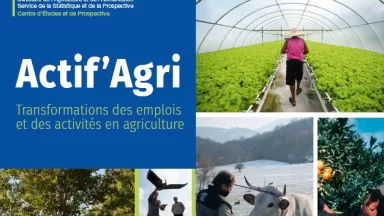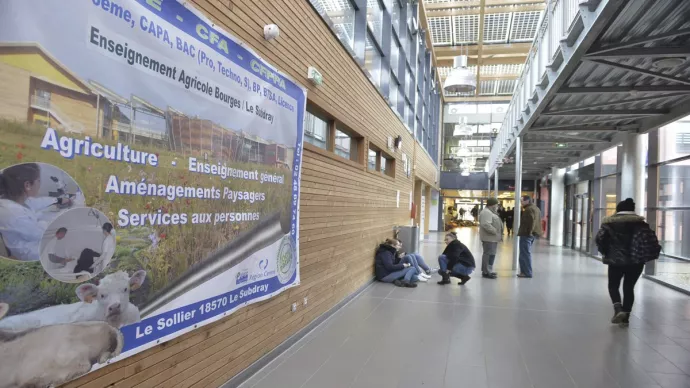
Vocational training and career changes towards agriculture
Partager la page
The Analysis Notes present, in four pages, the main points of discussion on a current topic relevant to the areas of activity of the Department of Agriculture, Agri-Food, and Food Sovereignty. Depending on the topic, they take a forward-looking, strategic, or evaluative approach.
Vocational training and career changes towards agriculture - Analysis n°223
At a time when the renewal of the agricultural workforce is a decisive challenge, pathways into farming are opening up to people who are changing careers from diverse backgrounds. In this context, continuing agricultural education constitutes an important step, giving access to qualifications. The analysis of a vocational training course for a “farm business manager” certificate and of its audience shows the variety of profiles involved and their confrontation with the reality of the farmer’s occupation. It also highlights the opportunities offered by obtaining a qualification, as well as its limitations for entering agriculture.
This text was written by a researcher as part of a collaboration with the Centre for studies and strategic foresight on the occasion of his or her talk during a “CEP Meeting”. The CEP Meetings bring together, in an informal manner, researchers, experts and members of the administration for the presentation and discussion of research work on subjects that are priorities for ministry policy. Consequently, this text does not express the official positions of the Ministry of Agriculture and Food Sovereignty.
Introduction
In France, as in most OECD countries1, the issue of renewing the workforce is at the heart of current concerns about the agricultural world. Faced with the decline in the number of farms and the increasing average age of farmers2, an Orientation Pact for the renewal of generations in agriculture was presented by the Minister of Agriculture and Food Sovereignty3. At the same time, entry pathways into farming have become more complex: farmers’ children pursue professional activities in other sectors before setting up, farm take‑overs are increasingly taking place outside the family framework and peoplewithout any farming background wish to devote part of their careers to it.
To better understand these changes in career trajectories, research was carried out on a still little‑studied stage of moves into agriculture – that of continuing training. Obtaining an agricultural qualification equivalent to the baccalaureate, such as the Vocational Certificate in Farm Management (Brevet professionnel responsable d’entreprise agricole - BPREA), gives access to professional capacity and public start‑up aid, which can amount to several thousand euros. These financial resources are all the more necessary as they partly compensate for the absence of inherited productive assets4. Thus the Agricultural training and Promotion Centers (Centres de formation professionnelle et de promotion agricole - CFPPA), responsible for delivering the public service of continuing agricultural training, are key institutions in career change pathways into agriculture.
At first created to combat inequality of opportunity by providing training and advancement for agricultural workers, the CFPPA have today become an integral part of the public continuing training system. There were 28 at their creation in 1968 and there are now 156 spread across the whole of France. In 2018, 75 % of the hours delivered in these public centres were devoted to courses leading to qualifications or with a professional purpose5. Among these, the courses preparing for the BPREA form their core activity. They are increasingly open to new audiences.
The survey focused on a CFPPA in a very urbanised region, delivering a BPREA specialising in organic market gardening aimed at employees and jobseekers benefiting from dedicated schemes. Participant observation6 and repeated semi‑structured interviews, during and after the course, were conducted with a class of 15 trainees from the 2017‑2018 intake (the last interview dates from 2021). The files of the 127 trainees who attended this course between 2015 and 2019 were then processed in order to identify socio‑demographic characteristics as well as educational and professional trajectories. Finally, the archives of the Ministry of Agriculture and of the CFPPA were analysed to trace more broadly the socio‑historical dynamics of the transformation of agricultural training provision.
To study the role of an agricultural qualification in career changes into agriculture, the first part of this note describes the public attending the course, their aspirations and the way they view the passage through the BPREA. The second part presents the opportunities offered by obtaining the qualification and its limitations in installation pathways.
Paths and aspirations of learners
Initially intended to raise the level of training of farmers, the CFPPA have undergone major changes since the 1980s. Unlike other public training centres, some CFPPA have experienced strong growth. Faced with the decline of their original audience, some of them have adapted their offer. Thus the BPREA studied, initially specialising in arable crops and aimed at farmers, farmers’ children and local farm workers, is now devoted to organic market gardening. It is aimed at new audiences, remote from the agricultural world, benefiting from schemes for employees and jobseekers. The CFPPA, being the only one authorised to award this certificate in the region, faces strong demand and welcomes several dozen trainees each year.
A heterogeneous audience converging towards an alternative agricultural model
Access to the BPREA depends on employment status. First, the individual training leave (congé individuel de formation – CIF) allows employees to follow a long training course on their own initiative. It mainly concerns employees on permanent contracts whose length of service is equal to or greater than twenty‑four consecutive months, and who must prepare a file with the CIF management fund7 or, in certain cases, with their approved joint collecting body (OPCA), which is responsible for selecting the applications. In this situation, trainees continue to be employees of their company. The FONGECIF covers their pay and the cost of the training.
The second route concerns jobseekers. The decentralisation laws8 entrusted the Regional Councils with funding training places through public contracts. Recruitment of jobseekers offers greater freedom to the training centres that are responsible for allocating the funded places.
The same applies to the third route of access to the BPREA, which mainly concerns public‑sector employees and self‑employed workers, who have to finance the training themselves (€11 000). The former may continue to receive their income but must then repay three years to the State. For the self‑employed, the public service for employment (Pôle emploi) may in some cases cover the cost of the training but not the allowances, which makes attendance over nine months particularly expensive. Between 2015 and 2019, the organic market‑gardening BPREA course studied mainly welcomed jobseekers (59 %), more than a third of people in CIF (36.9 %) and few self‑funded participants (4.1 %).
Like secondary agricultural education, which today welcomes a diverse public9, this organic market‑gardening BPREA course is taken by people from a variety of backgrounds, as shown by the occupational origin of the 127 people present between 2015 and 2019 (Table 1): 18 % of them are from managerial and higher intellectual occupations, 32 % from intermediate occupations, and 22 % from the group of employees. Among the 23 % of workers who took part in the training, only a third were agricultural workers. For most of them, it was their first experience in the process of re‑training before starting the course.
Table 1 – Sociodemographic data of trainees on the organic market‑gardening BPREA in the CFPPA studied, 2015‑2019
|
2015 |
2016 |
2017 |
2018 |
Cumulative |
||
|---|---|---|---|---|---|---|
|
Statuts |
In employment |
7 (39 %) |
15 (38 %) |
15 (50 %) |
20 (51 %) |
57 (45 %) |
| Last occupation |
Workers |
4 (22 %) |
12 (30 %) |
5 (17 %) |
8 (21 %) |
29 (23 %) |
|
Employees |
5 (28 %) |
8 (20 %) |
8 (27 %) |
7 (18 %) |
28 (22 %) |
|
|
Intermediate |
6 (33 %) |
10 (25 %) |
8 (27 %) |
17 (44 %) |
41 (32 %) |
|
|
Managers and |
3 (17 %) |
8 (20 %) |
7 (23 %) |
5 (13 %) |
23 (18 %) |
|
|
Other and |
0 (0 %) |
2 (5 %) |
2 (7 %) |
2 (5 %) |
6 (5 %) |
|
| Qualification obtained |
< Baccalaureate |
2 (11 %) |
4 (10 %) |
4 (13 %) |
5 (13 %) |
15 (12 %) |
|
Baccalaureate |
7 (39 %) |
12 (30 %) |
9 (30 %) |
7 (18 %) |
35 (28 %) |
|
|
> Baccalaureate |
9 (50 %) |
24 (60 %) |
17 (57 %) |
27 (69 %) |
77 (60 %) |
|
|
of which |
0 (0 %) |
0 (0 %) |
2 (7 %) |
1 (3 %) |
3 (2 %) |
|
| Age |
19-33 years |
11 (61 %) |
22 (55 %) |
15 (50 %) |
25 (64 %) |
73 (57 %) |
|
34 years |
7 (39 %) |
18 (45 %) |
15 (50 %) |
14 (36 %) |
54 (43 %) |
|
| Gender |
Female |
7 (39 %) |
15 (38 %) |
11 (37 %) |
21 (54 %) |
54 (43 %) |
|
Male |
11 (61 %) |
25 (62 %) |
19 (63 %) |
18 (46 %) |
73 (57 %) |
|
| Total |
18 |
40 |
30 |
39 |
127 |
Source: author, based on trainee files from the training centre.
Three types of trajectories: the disenchanted, the downgraded and the detached
Biographical interviews and analysis of the application files of the 15 trainees we followed recount the educational and professional trajectories of these candidates as well as their initial relationship with agriculture. They can be divided into three groups: the “downgraded” (7 cases out of 15 trainees), the “disenchanted” (5/15) and the “detached” (3/15). These contrasting trajectories explain their different aspirations for agriculture and the training, and the way they expressed them before entering the CFPPA.
The downgraded are mainly young men from families that placed great importance on schooling but who were unable to convert their educational investment into professional status. They all hold a baccalaureate but dropped out of higher education to take up subordinate positions in employment. Their aspiration to agriculture is less a break than a continuation of their trajectory. Some were already growing vegetables in community or family gardens before starting the course, and they learned to maintain a vegetable plot during holidays with grandparents who were farmers, or during occupation struggles such as at Notre‑Dame‑des‑Landes. Several of them also worked in retail, where they acquired knowledge in marketing and quality management of food products. By enrolling on a course in organic market gardening, they are seeking a path to reclassification that professionally valorises their self‑production practices and their knowledge of food products.
The disenchanted share with the downgraded a family investment that is relatively important in schooling. In their case it materialised in the obtaining of a higher education diploma. Holders of degrees up to doctorate level, they have had access to stable managerial and executive jobs. These salaried positions have given them comfortable financial situations (owners of their main residence and sometimes a second home). But they have experienced crises that have led them to “professional disenchantment”10. Gaining independent status is then seen as a way of better combining their professional and family lives while enhancing their skills. As with the downgraded, their distance from agriculture is less than may be suggested by the statistical categories. They are relatively close to the agricultural world, as children or grandchildren of farmers or because they have a professional activity within the agricultural sector (agricultural press, integration project, veterinary practice). However, their knowledge of agricultural practices was superficial before entering the course. Entering the BPREA is a way of acquiring professional legitimacy through the qualification and preparing for a new activity with an ecological connotation that is socially and symbolically valued.
Finally, the detached are over 40 and therefore can no longer apply for the public start‑up aid scheme. Their educational and career trajectories have been less favourable than those of the other two groups. The educational credentials they hold have less value, either because they are at a lower level or because they have depreciated over time. They have changed sectors of activity several times, but remained in low‑skilled jobs. These trainees are relatively detached from professional issues and they can rely on their partner, who has a more stable job (in the public sector, for example), to follow a new course. For them it is less a professional issue than a tool for personal development.
Vocational training: confronting the reality of the occupation
The BPREA training system is not without constraints for trainees. Having to combine study time with other family activities puts them under pressure, especially for those with children. The great variety of subjects taught (accounting, agronomy, biology, production, practical work) is also a major source of uncertainty, particularly for those who have followed general curricula. Finally, the physically demanding nature of market gardening causes concern among older trainees and those who are not used to manual work.
Trainers use these uncertainties to confront trainees with the reality of the market gardener’s occupation, characterised by a certain economic and professional marginality. However, this marginality, which is new for many trainees, must fit into an economically profitable framework within their project, the main support for end‑of‑year assessment. This reinforces the feeling of having a long road ahead, which is expressed in the trainees’ files where their pathways are explicitly narrated. They divide it into a “before” and an “after” the course, which is then presented as the moment when they were able to “turn the dream into reality”.
Uses of the agricultural qualification: opportunities and limits in career‑change paths
Although the failure rate on the BPREA is very low11, access to the occupation of farmer remains difficult for former trainees. Few of them become farmers immediately after the course. Beyond the few cases of rapid installation (3 cases out of the 15 trainees followed), the interviews revealed two other types of trajectories: becoming a farm worker (5/15), or abandoning (sometimes temporarily) the idea of farming (7/15, including one person who did not obtain the qualification).
Rapid installation
Rapid installation mainly concerns the disenchanted who have significant economic resources. Holding a BPREA is not a sufficient condition to become a farmer, since this qualification cannot fully compensate for the lack of land, whose availability depends mainly on family and professional networks12. As a result, access to land is through other channels, in particular local authorities that have land to lease.
Many trainees are directly or indirectly from farming backgrounds. Emphasising this lineage can be a strategy to claim proximity to agriculture, when entering the course for example, but it is nonetheless real for a significant number of them. In these cases, becoming a farmer undoubtedly represents major professional mobility but also a return to their original milieu.
Holidays spent with farming grandparents may have helped to construct an idyllic and even romantic vision of agriculture. Belonging to farming families can also facilitate access to certain resources, such as land. During our interviews, many mentioned the difficulties encountered with their parents or grandparents when they announced their desire to become farmers. Aspiration to agriculture can be seen as a step backwards in families that have managed to escape the peasant condition, especially when expressed by those who have qualifications that are more marketable on the labour market.
Disagreements or tensions may also arise over the type of farming promoted. Indeed, returning to agriculture does not mean reproducing family farming models exactly. Several interviewees mentioned sometimes heated exchanges with their relatives on these issues, some finally giving up the idea of settling on their grandparents’ land to avoid a family conflict.
Becoming a farm worker
While rapid installation after the course concerns only a small proportion of former trainees, waiting situations are the most widespread. Once the course is over, the time comes for the first confrontations with professional agricultural organisations, particularly for those who have no links with the sector and are looking for land opportunities. Contrary to what many hoped, notably the disenchanted, the qualification is not enough to ensure legitimacy with traditional agricultural actors. And these disappointments are not experienced only with the dominant organisations in the sector. In fact, going through the course imparts to trainees productive knowledge that may run counter to the activist initiatives to which they had adhered before entering training. Going through the BPREA therefore places former trainees in an in‑between position. Socialised to the economic and agronomic constraints of the occupation, they no longer adhere to the most heterodox models, such as permaculture, which they had previously valued. At the same time, obtaining an agricultural qualification is not enough to give them full legitimacy with traditional agricultural structures. Neither completely outside the agricultural worlds nor fully part of them, former trainees find a reference group in the networks of organic and peasant agriculture.
Faced with these difficulties, some former trainees become farm workers and their incomes are then lower than those they earned in their previous jobs, especially for the disenchanted, who held positions of responsibility. What is more, this type of job is often precarious and part‑time, due to the seasonal nature of agricultural work13, which is testing for those who previously had stable jobs. It also weighs on family life. Several of the trainees followed experienced separations during this transitional period.
For others, such as the downgraded, who had already experienced such occupational instability during their careers, the discontinuity of farm work seems less constraining. On the contrary, it sometimes represents an opportunity to get to know several farming models and choose the one that suits them best before setting up.
Giving up
The third type of trajectory is characterised by an abandonment of the initial farming project. Sometimes temporary, giving up is reflected in a return to their former job or attempts at new retraining. Even in these cases, going through the BPREA is not without consequences. Attending the training centre and holding a new educational credential have consequences for trainees’ career paths.
Thus returning to one’s original job can be experienced as a real ordeal, especially if the desire to retrain was motivated by difficulties linked to the conditions of that job. Having kept in touch with their employer and faced with growing economic constraints, some finally return to their original activity, but as self‑employed. The knowledge acquired during the course allows them to view their relationship to work differently, even when they have been employees all their lives. With this new self‑employed status, their aim is to devote more time to non‑remunerative agricultural projects while continuing their professional activity.
For others, going through the course and obtaining the BPREA provides a “new authority” and a statutory competence14 once back in their original company. By asserting their new technical (e.g. “vegetable production”) and managerial knowledge, some can achieve a modest upward move in their profession15.
Conclusion
The role of vocational training is not limited to teaching scientific or technical skills. As an important intermediate stage in professional mobility towards agriculture, and yet little analyzed, it also contributes to the development of a “feasible” professional project. Although faced with great uncertainty, learners must project themselves into a specific professional universe.
Studying career changes under way towards organic market gardening has made it possible to highlight often little‑visible trajectories. Career changes into this sector are not only the preserve of former executives who, having managed to create their own farm, often enjoy high media visibility. They also concern young employees who find reclassification positions as farm workers. Others finally end up giving up, but going through continuing training is nonetheless not without effect: it can reinforce the wish for independence and facilitate upward professional mobility in their original occupations. By helping to open the boundaries between the agricultural group and other socio‑professional spaces, public continuing agricultural training is an instrument contributing to the renewal of the workforce in agriculture.
Jean‑Baptiste Paranthoën
Inrae‑Irisso
Notes de bas de page
1 - Campi, M. et al., 2024, “The evolving profile of new entrants in agriculture and the role of digital technologies, OECD Food”, Agriculture and Fisheries Papers, No. 209, OECD, https://doi.org/10.1787/d15ea067-en.
2 - Purseigle F., Hervieu B., 2022, Une agriculture sans agriculteurs, Presses de Sciences Po.
3 - Ministry of Agriculture and Food Sovereignty, 2023, Pacte d’orientation pour le renouvellement des générations en agriculture, press dossier, 15 December.
4 - Paranthoën J.-B., 2014, “Déplacement social et entrées en agriculture. Carrières croisées de deux jeunes urbains devenus maraîchers”, Sociétés contemporaines, No. 96, pp. 51‑76.
5 - Ministry of Agriculture, Portrait de l’enseignement agricole, 2020.
6 - A method of gathering information that involves being part of the context studied and spending time with the actors in it. In our case, we took part in several training modules as well as collective moments (meals, car journeys).
7 - At the time of the survey this fund was called FONGECIF. Since 2020 it has been known as Transitions Pro.
8 - Berthet T., 2010, “Externalisation et gouvernance territoriale des politiques actives de l’emploi”, Revue française de socio‑économie, No. 6, p. 131‑148.
9 - Mahé M., 2017, L’enseignement technique agricole : diplômes, insertions et perspectives d’emploi, Analyse No. 109, Ministry of Agriculture and Food, Centre for studies and strategic foresight.
10 - Denave S., 2015, Reconstruire sa vie professionnelle. Sociologie des bifurcations biographiques, Presses universitaires de France.
11 - For the 2017/2018 intake, only two people out of 30 did not obtain their qualification, one of them because they dropped out.
12 - Barral S., Pinaud S., 2017, “Accès à la terre et reproduction de la profession agricole. Influence des circuits d’échange sur la transformation des modes de production”, Revue française de socio‑économie, No. 18, pp. 77‑99.
13 - Roux N., 2022, La précarité durable, PUF.
14 - Bourdieu P., 1979, « Les trois états du capital culturel », Actes de la recherche en sciences sociales, n° 30, pp. 3-6.
15 - Further inquiries are developed in Paranthoën J.-B., 2021, « La formation continue publique en agriculture : mission impossible pour les Centres de formation pour la pro-motion agricole ? », Sociologie du travail, vol. 63, n° 4 ; Paranthoën J.-B., 2021, « Des reconversions professionnelles en train de se faire vers le maraîchage biologique. Ethnographie d’une formation », Travail et emploi, n° 166-167(3), pp. 103-129 ; Paranthoën J.-B., 2024, « Quand la porte des champs se referme. Logiques et limites de la reconversion du capital scolaire en agriculture », dans François Buton, En déplacement : le passage des frontières professionnelles en question, ENS Lyon, pp. 30-47.
Voir aussi
Qui s’installe en agriculture aujourd’hui ? - Analyse n°215
10 juin 2025CEP | Centre d’études et de prospective

Temps de travail et temps de vie des exploitants agricoles : quelles différences selon l’origine sociale ? - Analyse n°217
10 juin 2025CEP | Centre d’études et de prospective
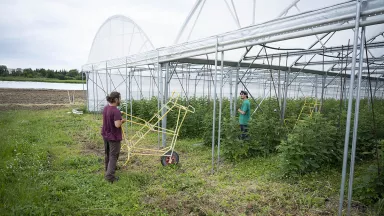
Les installés « non issus du milieu agricole » : des producteurs comme les autres ? - Analyse n°218
10 juin 2025CEP | Centre d’études et de prospective
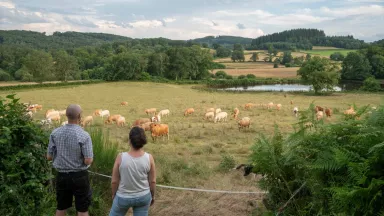
Agriculteurs « non issus du milieu agricole » en Bourgogne-Franche-Comté : trajectoires biographiques et entrées en agriculture - Analyse n°216
10 juin 2025CEP | Centre d’études et de prospective
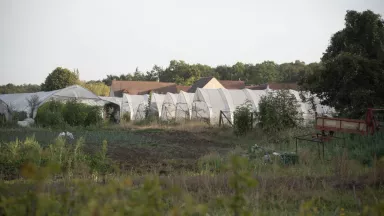
Devenir agricultrice en Quercy : entre recomposition et persistance des inégalités de genre - Analyse n°214
10 juin 2025CEP | Centre d’études et de prospective
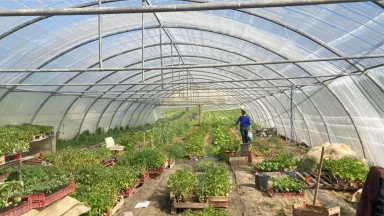
#ActifAgri : De l'emploi à l'activité agricole : déterminants, dynamiques et trajectoires
02 mars 2020CEP | Centre d’études et de prospective
